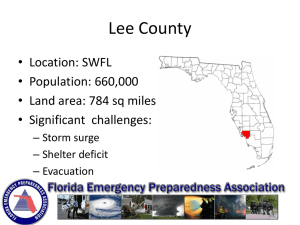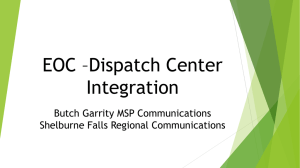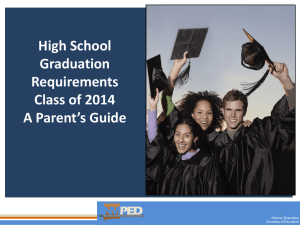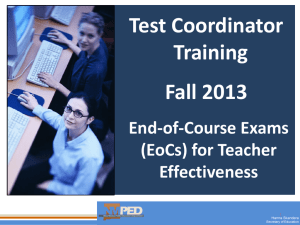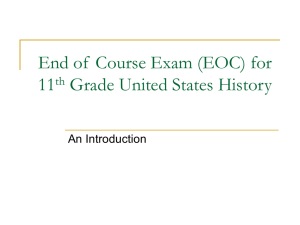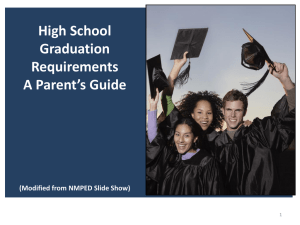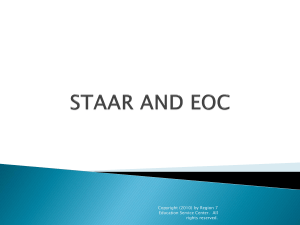EoCs - New Mexico State Department of Education
advertisement
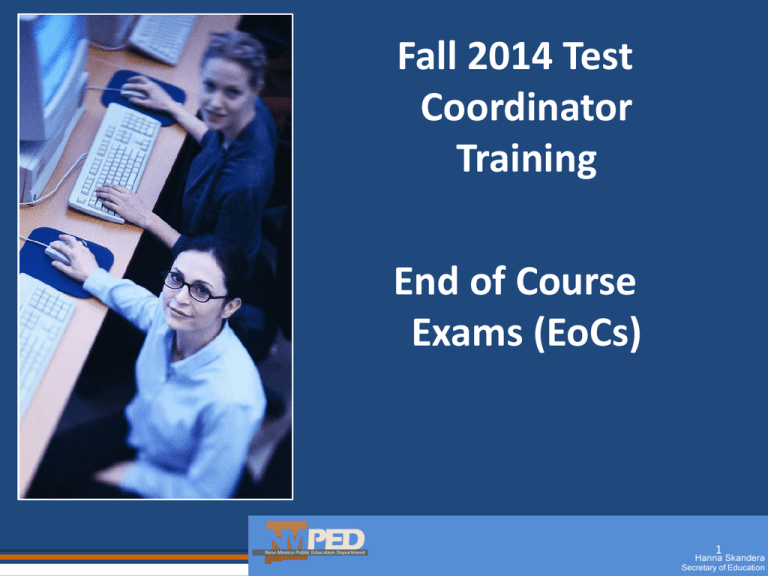
Fall 2014 Test Coordinator Training End of Course Exams (EoCs) 1 Purpose of an EoC Exam • Statewide curriculum alignment. • Determining and measuring teacher and school leader effectiveness—Educator Effectiveness System (EES) (6.60.8 NMAC). – The evaluation system must include measures of student achievement growth (50 percent): • SBA/PARCC—35% • Department approved assessments—15% • Providing an Alternative Demonstration of Competency (ADC) in the academic content standards required for graduation (6.19.7.7 NMAC). Developing an EoC Exam • Step 1: Identify the construct, domains, and indicators to be measured – standards based assessment. – The knowledge, skills and abilities proficient students should know and be able to do at the end of a course or grade. Developing an EoC Exam • Step 2: Develop a Table of Specifications. – Table of Specifications becomes the concrete assessment plan for the EoC exam. – What type of assessment is most appropriate for each domain? – What is the cognitive difficulty or cognitive demand for each domain? – How many items are necessary to comprehensively assess the knowledge, skills and abilities for each domain of the assessment? Developing an EoC Exam • Step 3: Develop the Assessment – Groups of teachers from across the state. – Training on item writing. – Collectively create items. – Produce test form. – Create and verify answer key. – Produce rubrics and administration guide for all constructed response and performance items. Developing an EoC Exam • Step 4: Content/Bias Review – Groups of teachers from across the state. • New and Previous – Training – Review blueprints – Review test items for content and bias – Verify logic of test form – Verify answer key Developing an EoC Exam • Step 5: Give the test and submit data. – Tests will be available online on Blackboard beginning spring 2015 – (Yay!) – Pilot fall 2014 (select districts/schools) – No cost to districts/schools – More information forthcoming Data Submission STARS SOAP STARS REPORTS EES Item Analysis ADC Standard Setting Revision Submission Full Approval Why is Submitting EoC Data Important? • Student Level Data is Used for – Standard Setting (passing scores for new tests) – Item Review – Student Records for passing an exam – Alternative Demonstration of Competency for Graduation – Educator Effectiveness System – Provides larger sample size Data Submission Two Required Submissions: 1) SOAP Item Data – Only for Select EoCs – Used for setting passing scores – Minimum 50 RANDOM student scores per test 2) STARS Overall Score – For ALL EoCs – For ALL Students EoC Reports in STARS STARS Reports • EOC Submission Validation Report – Student level validation errors for tests. – Report used by districts to validate 40, 80, 120 and End of Year EOC submissions. – Becomes a formal process for Fall 2014 STARS EoC Report Elements • • • • • • • • • • • • District Name District Code Location Name Location ID Student ID Student First Name Student Last Name Subject Subtest Identifiers Grade From Grade To Student Grade Level • • • • • • • • • • • • Max Score Raw Score Max Tests Subject Count Date Test Active Date Test Inactive Test Date Exists Error Date Error Score Error Grade Error Max Test Data Quality is Essential! • Data needs to be accurate • Follow instructions given by PED – Data Submission Guide – STARS Manual – Not sure—Ask! • Errors create delay in results • STARS EoC data submissions tied to 40/80/120/EOY day reporting Developing an EoC Exam • Step 6: Data Analysis – P-values – IRT analysis – Possible elimination of items – Flag items for further review Developing an EoC Exam • Step 7: Standard Setting – Groups of teachers • New and Previous – Set passing scores • Bookmark Method • Body of Work Method Developing an EoC Exam • Step 8: Content Review #2 – Groups of teachers • New and Previous – Review flagged items – Consider district/school/DTC/STC feedback Developing an EoC Exam • Step 9: Re-version and re-administer – Any change new version – Minor changes, passing score remains – Major changes, new passing scores must be set End of EoCs EoC Procedures • Current: paper tests • Upcoming: online hosting on Blackboard • • • • December: Blackboard pilot with select districts Spring: Widespread Blackboard administration • Paper administration will be permitted. • Data will be automatically be submitted to PED! Summer 2014 EoCs Summer 2014 EoCs EoC Administration Windows Window Students Dates Fall Students in 1semester courses and HS retakes 2 consecutive weeks during last 3 weeks of fall semester Winter HS retakes 1 week during first 3 weeks of spring semester Spring All students 2 consecutive weeks during last 3 weeks of spring semester Summer HS retakes and students in summer school 6/22 – 6/26/15 or last week of summer school course EoC Test Structure • Most Tests: Multiple Choice • (request from AAAC) • Elective Courses: Performance Components • HS: 90 minutes • MS and ES: 60 minutes EoCs: High Stakes Tests • Treat as Final Exams • Security Procedures are Essential! • Directions for Administration (DFA): administration procedures, teacher access, use of calculators, use of scratch paper, make-ups, accommodations, materials chain of custody, scoring requirements, administration script EoCs: High Stakes Tests • Testing Irregularities: submit to PED • DFA administration procedures will change with implementation of CBT. • Security will be easier to maintain. EoCs: Student Preparation • Teachers: • Access Blueprints (on PED website) • PBA: Access administration guides (on PED website) • DFA (on PED website) • NAEP Questions Tool (on NAEP website) EoC Questions? EoC Data Judy Harmon judith.harmon@state.nm.us EoC Procedures Joslyn Overby joslyn.overby@state.nm.us
